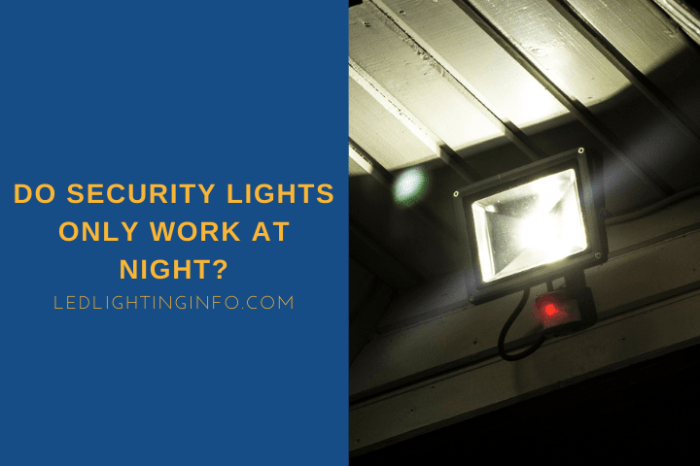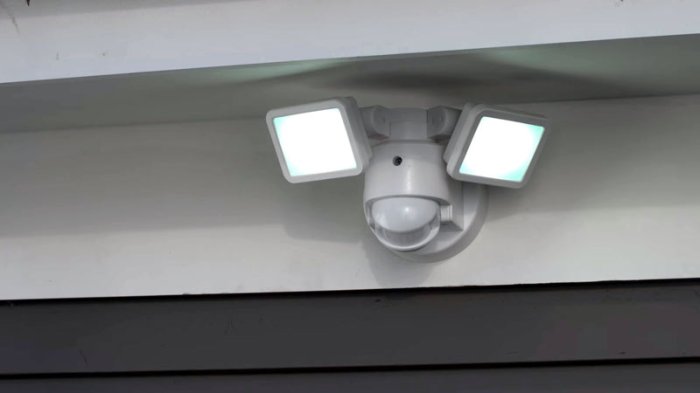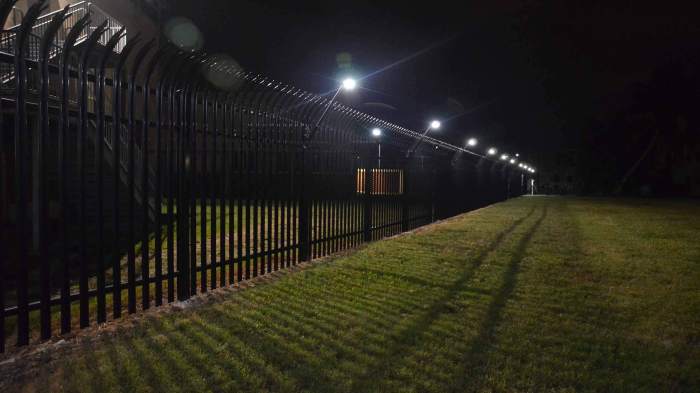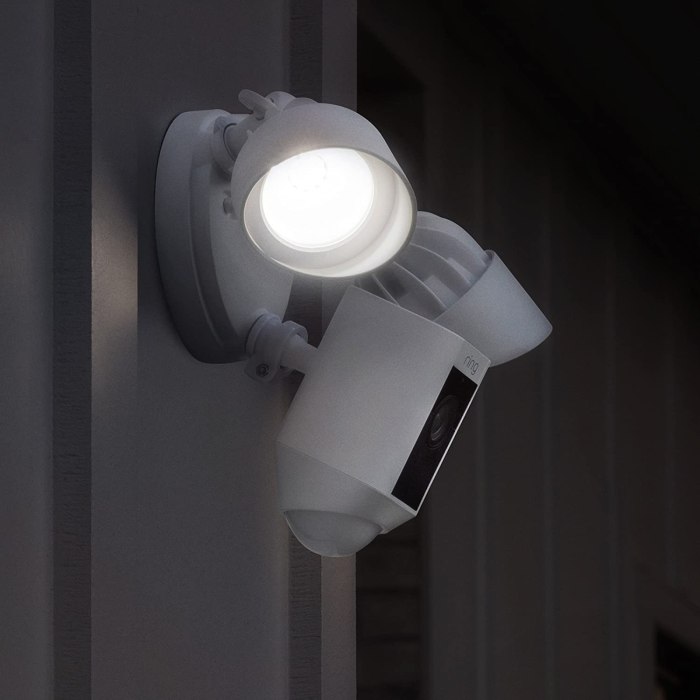Can security lights stay on all night? This seemingly simple question leads to a complex web of considerations, encompassing energy efficiency, environmental impact, and even the well-being of wildlife. While the idea of constant illumination might seem like a deterrent to crime, it comes with its own set of drawbacks.
Leaving your security lights on 24/7 can significantly impact your energy bill, and the constant light pollution disrupts the natural rhythms of nocturnal creatures. This article delves into the pros and cons of leaving security lights on all night, exploring alternative solutions and emphasizing the importance of sustainable lighting practices.
Energy Consumption and Cost

Leaving security lights on all night can significantly impact your energy bill. Understanding the energy consumption of these lights and exploring alternative options can help you save money and reduce your environmental footprint.
Energy Consumption of Security Lights
The energy consumption of security lights depends on the wattage of the bulb and the number of hours they are in use. A typical 100-watt incandescent bulb consumes 100 watts of power per hour. If this light is left on for 24 hours, it will consume 2,400 watt-hours (Wh) or 2.4 kilowatt-hours (kWh) of energy.
Estimated Monthly Cost
To estimate the monthly cost of leaving security lights on 24/7, consider the following:* Energy consumption:Assume you have two 100-watt security lights, each consuming 2.4 kWh per day. This totals 4.8 kWh per day.
Monthly consumption
Over a month (30 days), the total energy consumption would be 144 kWh (4.8 kWh/day30 days).
Average electricity rate
The average electricity rate in the United States is around $0.13 per kWh.
-
Estimated monthly cost
The estimated monthly cost would be approximately $18.72 (144 kWh
- $0.13/kWh).
The actual cost may vary depending on your electricity rate and the number and wattage of your security lights.
Savings with Motion-Activated Lights
Motion-activated lights offer significant energy savings compared to lights that remain on all night. These lights only turn on when motion is detected, reducing energy consumption by a considerable amount. * Energy consumption:Motion-activated lights may consume only a fraction of the energy used by continuously lit lights, as they are only on for a short period when motion is detected.
Cost savings
Depending on the frequency of motion detection, the cost savings can be substantial. In a typical residential setting, motion-activated lights could reduce energy consumption by 50% or more.
For example, if a motion-activated light is triggered only 10 times a day for 30 seconds each time, it might only consume 0.5 kWh per day, resulting in significant cost savings compared to a continuously lit light.
Safety and Security Considerations

Security lights are designed to deter crime by illuminating areas that might otherwise be dark and inviting to criminals. However, there are both advantages and disadvantages to keeping security lights on all night.
Potential Benefits of Constant Illumination
Constant illumination can create a sense of heightened security by making it more difficult for criminals to approach a property undetected. The presence of bright lights can act as a deterrent, making potential criminals think twice before attempting to break in or commit other crimes.
- Increased Visibility:Security lights illuminate areas, making it easier to see what is happening and potentially deterring criminals who prefer to operate in darkness.
- Improved Surveillance:Constant illumination allows for better surveillance, both by homeowners and by security cameras.
- Psychological Deterrent:The presence of bright lights can create a sense of unease and discourage criminals from approaching a property.
Potential Drawbacks of Constant Illumination
While security lights can deter crime, they also have potential drawbacks.
- Light Pollution:Security lights can contribute to light pollution, which can negatively impact wildlife, disrupt natural sleep cycles, and make it difficult to see stars at night.
- Blinding Drivers:Security lights positioned too close to roads can blind drivers, increasing the risk of accidents.
- Attracting Unwanted Attention:Bright lights can attract unwanted attention from insects, animals, or even curious neighbors, potentially creating a nuisance.
- Increased Energy Consumption:Leaving security lights on all night significantly increases energy consumption, leading to higher electricity bills.
Alternative Solutions

While keeping security lights on all night provides constant illumination, it comes with a significant energy cost. Fortunately, various alternative solutions can enhance security without sacrificing energy efficiency.
Motion-Activated Security Lights, Can security lights stay on all night
Motion-activated security lights are a popular alternative to continuously lit lights. These lights are equipped with sensors that detect movement within their range. When movement is detected, the lights automatically switch on, illuminating the area for a pre-set duration.
- Energy Savings:Motion-activated lights consume energy only when necessary, significantly reducing electricity consumption compared to constantly lit lights.
- Enhanced Security:The sudden illumination triggered by movement can deter potential intruders and alert homeowners to suspicious activity.
- Versatility:Motion-activated lights are available in various styles and sizes, making them suitable for different applications, including outdoor lighting, walkways, and garages.
Timer-Controlled Lights
Timer-controlled lights offer a balance between security and energy efficiency. These lights can be programmed to switch on and off at specific times, providing illumination during vulnerable hours without staying on all night.
- Scheduled Illumination:Timer-controlled lights can be set to illuminate the property during dusk and dawn, when crime rates are typically higher.
- Energy Efficiency:By only illuminating the area during designated hours, timer-controlled lights significantly reduce energy consumption compared to continuous lighting.
- Flexibility:Modern timer-controlled lights often offer programmable options, allowing users to customize the schedule based on their specific needs and preferences.
Other Security Measures
Beyond lighting, various other security measures can contribute to a safer environment.
- Alarms:Security alarms, including motion detectors, door and window sensors, and sirens, can deter intruders and alert authorities in case of a break-in.
- Surveillance Cameras:Surveillance cameras provide visual documentation of activity around the property. They can deter crime by making potential intruders aware they are being monitored and can assist in identifying suspects if a crime occurs.
Environmental Impact: Can Security Lights Stay On All Night

Continuously illuminating security lights contribute significantly to light pollution, a growing environmental concern. Light pollution disrupts natural ecosystems and affects human health. Understanding the impact of security lights on the environment is crucial for making informed decisions about their use.
Light Pollution and Its Effects
Light pollution is the excessive and misdirected use of artificial light, particularly at night. Security lights, when left on throughout the night, contribute to this problem. Light pollution has several negative consequences for the environment and human health:
- Disruption of Nocturnal Ecosystems:Many animals, including insects, birds, and mammals, rely on natural darkness for survival. Artificial light can interfere with their navigation, foraging, and breeding behaviors. For instance, light pollution can disorient migrating birds, leading to collisions with buildings.
- Skyglow and Stargazing:Light pollution obscures the night sky, making it difficult to observe stars and other celestial objects. This impacts astronomy research and stargazing, reducing our ability to appreciate the beauty and grandeur of the cosmos.
- Impacts on Human Health:Studies suggest that exposure to artificial light at night can disrupt the production of melatonin, a hormone essential for regulating sleep cycles. This disruption can lead to sleep disorders, increased risk of obesity, and other health problems.
Sustainable Lighting Practices
Adopting sustainable lighting practices can minimize the environmental impact of security lights:
- Motion-Activated Lights:Motion-activated security lights only illuminate when triggered by movement, reducing energy consumption and light pollution. This is a highly effective and efficient approach for deterring crime while minimizing environmental impact.
- Shielded Lighting:Using shielded lights directs light downwards, preventing it from scattering into the sky and creating light pollution. Shielded fixtures minimize the impact on wildlife and the night sky, ensuring that light is focused where it is needed.
- Low-Intensity Lighting:Choosing low-intensity lights for security purposes reduces the amount of light emitted, mitigating light pollution and energy consumption. While still providing adequate illumination, these lights minimize the negative effects on the environment.
- Warm-Colored Lights:Warm-colored lights (with a lower color temperature) are less disruptive to wildlife and human sleep cycles than cooler-colored lights. Opting for warm-colored security lights reduces the overall impact on the environment and helps maintain natural darkness.
Final Review

Ultimately, the decision of whether or not to leave security lights on all night depends on your individual needs and priorities. By weighing the potential benefits against the drawbacks, you can make an informed choice that balances safety and security with environmental responsibility.
Remember, there are numerous alternative solutions available, such as motion-activated lights and timer-controlled systems, which can provide adequate security without the downsides of constant illumination.